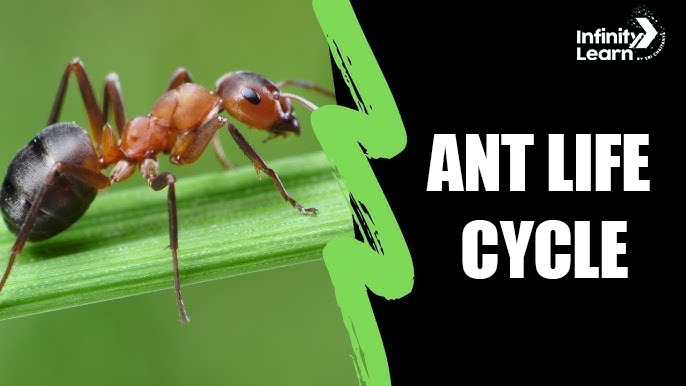Table of Contents
Ant Life Cycle: The life cycle of an ant has four main stages: egg, larva, pupa, and adult. It starts when the queen ant lays tiny, white, oval eggs. When these eggs hatch, they turn into legless larvae that need food and care from worker ants. The larvae go through several changes (called molts) before becoming pupae, during which they grow legs and antennae.
Finally, the pupae turn into adult ants, ready to help in the colony. This process, called complete metamorphosis, can take a few weeks to months, depending on the type of ant and its environment. The article below explains the ant life cycle in detail.

Life Cycle of Ant
The life cycle of an ant is interesting and has four main stages: egg, larva, pupa, and adult.
Ant Egg: An ant starts as a tiny, oval-shaped egg. These eggs are soft and about the size of a period at the end of a sentence.
Ant Larva: After hatching, the egg turns into a larva. Larvae have no legs and depend on adult ants for food. They grow quickly and shed their skin several times.
Ant Pupa: When the larva is big enough, it changes into a pupa. During this stage, the ant changes a lot. Pupae look more like adult ants but keep their legs and antennae tucked against their bodies. Some types of ants make cocoons for safety.
Ant Adult: Finally, the pupa becomes an adult ant. Adult ants can be queens, workers, or males. Queens lay eggs, workers do tasks like gathering food and caring for the nest, and males mainly mate with queens.
The whole process from egg to adult can take a few weeks to months, depending on the type of ant and its surroundings.
Reproduction in Ants
Ant reproduction is an interesting process that relies on a well-organized structure within the colony. The steps below detail the complete process of reproduction in ants:
- Queen Ant: The queen is the main figure in reproduction. She mates with male ants, called drones, and stores their sperm to fertilize her eggs throughout her life.
- Drones: Male ants, or drones, only exist to mate with the queen. After mating, they usually die.
- Worker Ants: These are female ants that cannot reproduce. They take care of the queen’s eggs and larvae, gather food, and keep the nest clean and safe.
- Life Cycle: The queen lays eggs, which hatch into larvae. Worker ants feed and care for the larvae until they become pupae and eventually grow into adult ants.
- Mating Flights: At certain times of the year, new queens and males leave the nest to mate. After mating, the new queens find a place to start their own colonies.
Ants’ ability to reproduce effectively and maintain a structured colony is essential for their success as a species.
Ant Life Cycle Time
Ants go through complete metamorphosis, which includes four clear stages: egg, larva, pupa, and adult. How long each stage lasts can change based on the type of ant, temperature, and food supply. Usually, the egg stage lasts a few days, the larva stage can last from one week to several weeks, and the pupa stage may take a few weeks to several months. Overall, the process from egg to adult usually takes about 8 to 10 weeks for worker ants. Once they become adults, ants can live for several weeks to years, depending on their job in the colony.
Ant Life Cycle Day
The life cycle of an ant is a process with four main stages: egg, larva, pupa, and adult. It starts when the queen ant lays tiny, oval, white eggs. These eggs hatch into legless larvae in about 7 to 14 days. The worker ants take care of the larvae and feed them as they grow and shed their skin several times.
Once they reach a certain size, the larvae enter the pupal stage, where they grow features like legs and antennae. This stage can last from a few weeks to months, depending on the environment. Finally, the pupae turn into adult ants. At first, these adult ants are soft and light-colored, but their outer shell hardens and darkens over time, completing the life cycle.
Ant Larvae
Ant larvae are the second stage in an ant’s life cycle. They are small, worm-like creatures that rely completely on adult ants to survive.
Key features of ant larvae:
- Appearance: They are usually white or yellowish-white and have no legs or eyes.
- Diet: Adult worker ants feed the larvae with regurgitated food or special secretions.
- Growth: Larvae grow quickly during this stage and shed their skin several times as they get bigger.
- Future roles: What they become in the colony depends on the food they receive. Those that eat more nutritious food are more likely to become queens or males, while others turn into worker ants.
- Sensitivity: They are very sensitive to temperature and humidity, so they need a safe environment within the colony.
- Defense: Some ant species have larvae that can produce a defensive liquid to scare off predators.
- Symbiotic relationships: Certain ant species have partnerships with other insects, like aphids, where the larvae get honeydew in exchange for protection.
Ant Pupae
Ant pupae are the resting stage in an ant’s life cycle. During this time, the larva goes through a big change and becomes a fully-formed adult.
Key features of ant pupae:
- Appearance: They look a lot like adult ants but have their legs and antennae folded against their bodies.
- Cocoon: Many types of ants spin a silk cocoon around themselves for protection during this stage.
- Metamorphosis: Inside the pupa, the larva’s body changes significantly, developing into the features of an adult ant.
The role of pupae in a colony:
- Future Workers: Most ant pupae will grow into worker ants, which are essential for the colony.
- Potential Queens or Males: In some species, certain ant pupae may become queens or males, who are responsible for reproduction.
Care from Adults: Adult ants take care of the pupae, making sure they are safe and developing well.
FAQs on Ant Life Cycle
How long is the life cycle of an ant?
The life cycle of an ant includes four stages: egg, larva, pupa, and adult. This entire process usually takes about 6 to 10 weeks, depending on the type of ant and environmental factors.
Do ants live 30 years?
Most ants have shorter lifespans, but queen ants can live up to 30 years if conditions are right. Worker ants typically live for a few months to a year.
Are ants male or female?
Most ants in a colony are female, including the queen and worker ants. Male ants, known as drones, are less common and mainly exist to mate with the queen.
How do ants give birth?
The queen ant lays eggs, which hatch into larvae. Worker ants take care of these larvae until they grow into pupae and eventually become adult ants.
Can ants produce sperm?
Yes, male ants (drones) produce sperm. They mate with the queen during a mating flight, and the queen stores this sperm to fertilize her eggs throughout her life.
What happens when a queen ant dies?
When a queen ant dies, the colony can struggle. Without a queen to lay new eggs, no more workers are produced, and the colony will gradually decline as the existing workers die.









